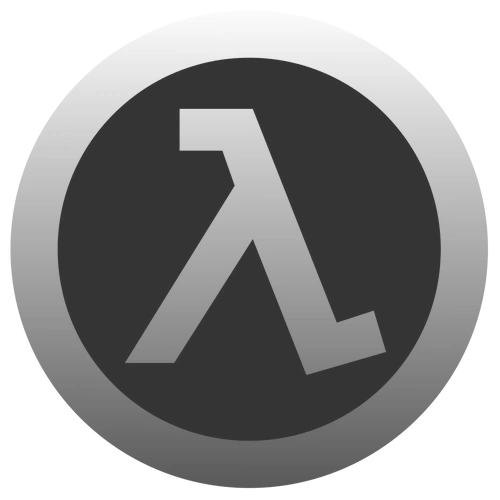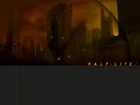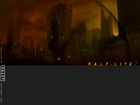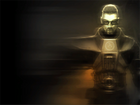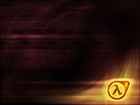No edit summary |
m (clean up) |
||
| Line 1: | Line 1: | ||
| − | + | {{Article|rw|hl2}} |
|
{{Cut}} |
{{Cut}} |
||
{{stub}} |
{{stub}} |
||
Revision as of 01:05, 3 January 2012
| You can help by correcting spelling and grammar, removing factual errors, rewriting sections to ensure they are clear and concise, and moving some elements when appropriate. Visit our Cleanup Project for more details and, please, notify the administrators before removing this template. |
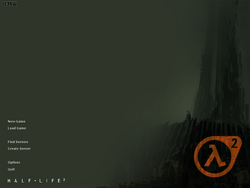
The Half-Life 2 menu as of 2003.
- "There is a lot of value in refinement. There's an aggressive statement of this principle, which isn't entirely true but it's still interesting: It doesn't matter what we cut, so long as we cut it and it gives us the time to focus on other things, because any of the options will be bad unless they're finished, and any of them will be good if they are finished."
- ―Gabe Newell[src]
The Half-Life 2 Beta (also known as the Half-Life 2 Alpha, the Half-Life 2 leak, the Beta or the leak), is a generic name that refers to Half-Life 2 during its development stages, from 1999 to its release in 2004.
Original plot

The Skyscraper.
The book Half-Life 2: Raising the Bar and the numerous leaked files revealed many of the game's original settings and action that were either cut down or removed entirely from the final game. Half-Life 2 was originally intended to be a far darker game based on far grittier artwork where the Combine were more obviously draining the oceans for minerals and replacing the atmosphere with noxious, murky gases.
Half-Life 2 was also originally intended to be much more diverse in settings, and the original journey was extremely long (to the extent that the game felt almost overblown, with little time being spent on developing existing characters; one of the key reasons for it being cut). Several City 17 levels at the start of the game and complete chapters from the second half of the game were completely removed and sometimes re-introduced in the subsequent Half-Life 2 episodes.
Parts of the book Half-Life 2: Raising the Bar and the leaked files detail how Gordon would fight alongside characters such as Odell in the Borealis, as well as fighting together with Captain Vance and Vance's forces, the Conscripts, in the Air Exchange, the Weather Control and the rooftops of City 17. Originally, Eli and Alyx Vance had no relation, and Eli's lab was located in a cave in a scrapyard and was much rougher than the better equipped laboratory within a hydroelectric power station in the retail version (the scrapyard area where the Gravity Gun tutorial takes place, being an auxiliary area as opposed to the bulk of the lab, is reminiscent of the original concept). The Citadel also looked very different, it was more round than the bulky Citadel from the final version.
Style
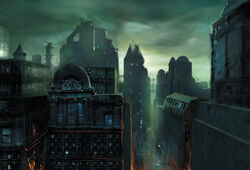
Concept art for the early City 17, with what appears to be the inner wall on the right.
While the playable game leaked in 2003 is quite similar to the retail product and already heavily trimmed, this earlier period of development of the game shows a quite different style. At this point, City 17 was an American East Coast-like city based on Washington, D.C.,[1] with many huge skyscrapers, and had a very basic, blocky FPS design.[2] It was more faithful to the concept art seen in Raising the Bar: darker, gothic, sinister, rainy, foggy, gritty, with a lot of brick, metal and glass, getting along well with the cut concept of the Combine replacing the air with poisonous gas and draining the oceans. It was therefore a much more dystopian, Orwellian universe (even though the final product is still quite Orwellian) even with touches of cyberpunk/steampunk style, in the vein of the book/film 1984 or other films such as Dark City, City of Lost Children or Avalon. It was also more faithful to Viktor Antonov's early concept art and work on the game.
The Combine was rather using and recycling the existent human materials and buildings, instead of adding their own technology to them. This is why, for instance, the early Citadel had its walls covered with tiles.
During the timespan leading to the 2003 leak, the team added more periods, such as the 30's, the 40's and the 70's, to finally get to a more Eastern post-Communist style we see in the retail version of the game, with older and smaller buildings, and a bright universe instead of a dark one, which is more in the vein of the original Half-Life. The Ravenholm levels are a reminiscence to the original style, even though the American East Coast-style skyscrapers were all removed.
Note that not all the concepts were not present in the development process at the same time, since the game had still a very rough, work-in-progress state.
Leaked files
Playable game
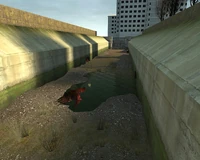
Bullsquids in the Canals.
The files leaked in 2003 consist in a playable game available in two versions, the "anon-hl2" leak and the "Russian" leak, which are slightly different. The "Russian" copy of the leak is, of course, based upon the original 100 part leak "anon-hl2". One of the few notable differences between the two is the presence of a installer, while the "anon-hl2" leak consists of 100 rar files. The "anon-hl2" beta contains at its root a .txt file last edited in October 2003, with these words:
Just create a server to play.
in the console, use "noclip" when it's stuck.
Really full of bugs, sure that valve won't release it before a while.
Have fun !!!
The work-in-progress nature of the game makes it obviously very incomplete and quite unstable, and some maps won't load. At this time, chapters like the Air Exchange, the Borealis, or the Skyscraper were already cut, and City 17 already had its Central/Eastern European style, making this game very similar to the retail product and representing what Half-Life 2 looked like in 2003. Therefore, the cuts were not made because of the leak, but for other reasons, and much earlier in the development process.
Features from the playable game
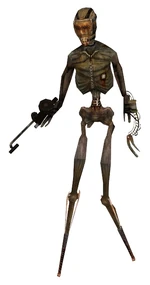
The Stalker as seen in the playable game.
- The interface appears to be based off of the Steam version of the first Half-Life. For example, it has "Software", "OpenGL", and "DirectX" listed as usable renders in the "Video" tab, but the Source engine used DirectX only when it was released.
- There is extremely basic multiplayer support. It can support very few players. Interestingly, one of the tabs in the "Create a server" option is named "CPU Players".
- The game treats each single-player session like multiplayer; there is a scoreboard that can be brought up with TAB, and the player can type messages. If the player wants to follow the storyline, they have to access the map through the console, otherwise the next map will not load. It is however quite difficult to follow the incomplete storyline, and several maps won't load and crash the game.
- There is basic DirectX6 support, which consists of a few low-poly character models and a DirectX6 version of one of the Coast maps.
- The engine is of course less optimized than the one used by the final game.
- There is no built-in anti-aliasing. It can however be achieved with most recent graphic cards that override the games settings.
- The source code contains a folder called 'ivp' (IVP stands for Ipion Virtual Physics, a physics engine from Ipion Software that was bought out and brought into Havok 1) which contains Source's original physics engine from early 2001 containing IVP code (dating from 1999-2000) incorporated into the Havok code. The VPhysics engine based off Havok 2 is also present in a separate folder and is the final version retained in the Source engine.
- The game uses a unique ammo system not seen in the final version. Ammo is broken up into three types; small, medium, and heavy. The SMG2 uses small; the Pistol, SMG1, AR1 and OICW use medium; the HMG uses heavy.
- The Colt Python and Resistance Crossbow were not implemented in the game at the time of the leak, and as a result, do not exist in the playable prototype.
- Several sound files from chapters already cut in the playable version can still be found in the sound folders, such as early Breencast clips by the Consul, Conscripts dialog involving an Overwatch Sniper, Overwatch Soldiers chatting in the Skyscraper, a scripted sequence involving three homeless Citizens (nicknamed "hobos", one of them named "Regis") talking about Vienna sausages (one of the them has the same voice as Odell) in a City 17 underground prototype (in the maps "
vienna_talk" and "vienna3", last edited in 2003)[2], a scene involving Alyx (voiced by another woman) and a Strider chase, and dialogues and music from the film Aliens, to be used for lip sync tests in the maps "aliens_test" and "testroom_ripley" (the dialogues) and the surreal map "ickypop" (the music).[3][2]
NPC differences
- The Combine Soldiers use the SMG1, the shotgun, and the OICW.
- The Gunship will freely use the laser on its stomach, but it is very difficult for it to actually hit the player.
- The Gunship and the Strider are invulnerable.
- The Dropship uses a trash can as a placeholder for its cargo holder.
- Citizens have a different outfit.
- Stalkers are much more aggressive and inflict much more damage than the ones encountered in Episode One, can run away to dodge attacks, and will actively pursue the player.
- Citizens are weaker, can barely kill anything on their own, and can only use the SMG1 and Pistol correctly.
WC mappack
A Breencast device hanged to a Civil Protection building near the Manhack Arcade.
Other files consisted in a group of several zip files nicknamed "WC mappack" (WC stands for Worldcraft, the early name for Hammer, the level editor), containing around 1300 incomplete VMF maps (VMF stands for "Valve Map File") of the very early chapters already cut in the playable game mentioned above (most of them are repeated and almost identical), demo/prototype maps and the maps from the playable version, spread in around 60 folders named by the developers who worked on them, and making up around 3 gigabytes. These maps can be opened in Hammer and can be run in any Half-Life game after texture fixing (since several textures can be missing, especially the original Combine metal variations) and compiling into BSP maps (using the option "Create a Mod" in the SDK and putting the textures from the playable Beta in its folder will do most of the preliminary work, as most of the textures will be missing if the compiled map is played on a released game). The maps still have the date they were last modified, which can give other clues about the game development. Most of the maps are very old and were last edited/created in 2001 or 2002.
The leaked files available on the Internet are obviously only parts of the original files used in the development of Half-Life 2, since many more maps, models, sounds, scripts, and textures exist, as well as more than 50,000 reference photos taken in USA and Europe used for design inspiration.[1]
These files can be easily found on the Internet, but note that it is somehow illegal to redistribute them, even though users cannot be blamed for wanting to see some behind-the-scene material. However the illegal status is now quite blurry since the game is now released.
Cut features
Weapons
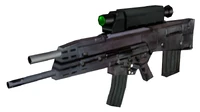
The XM29 OICW.
Throughout the development of Half-Life 2, its impressive arsenal of weaponry varied considerably, and it contained several different weapons than when the game was first made public, weapons that were later cut before the final release.
It has been suggested that the bulk of the weapons were cut due to the fact that they were too similar to one another, as the AK-47 served a very similar role to the AR2, and the OICW the same to the SMG1, and that it would not be very believable to hold more than 25 weapons, even though a limited weapons system was implemented at some point, having the player throw a weapon before picking up a new one.[4]
Most, if not all of these weapons are usable in the playable Beta and the mod Missing Information, although sometimes with some changes.
Vehicles
- AirEx Truck (as a static prop)
- Digger
- Jet Ski
- Isreali Merkava (used by the conscripts)
- VAB APC (also used by the conscripts)
Friendly fire
Half-Life 2 originally featured friendly fire, as with Half-Life. Valve found this to be annoying to playtesters, as they would often accidentally kill their teammates, so it was changed so the weapons do no damage to friendlies.
Cut enemies
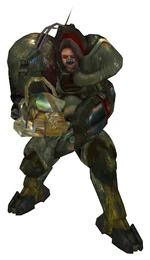
The Combine Guard.
Many enemies were cut. The most prominent ones include:
- The Combine Assassin. A female soldier, she is the successor to the Half-Life Black Ops.[1] She is included in Half-Life 2: Survivor.
- The Alien Assassin, a humanoid creature dressed in black that would behave like a stereotypical ninja. It is known that by animations it was to drop smoke grenades and throw Hopwire Grenades. Parts of the AI was reused for the Fast Zombie[1].
- The Bullsquid. It behaves exactly like the one from the original Half-Life, but has reddish skin. One of the leaked maps set in the City 17 canals has a section designed around swimming Bullsquids, but they will never enter the water.
- The Houndeye. It was to behave similarly to the one in the original Half-Life, but there was to be more emphasis on the Houndeyes behaving like a pack of wolves. Its leaked model is corrupt, but its textures are still viewable.
- The Cremator. It would clean the streets of bodies after a skirmish with a massive acid gun called the Immolator, which would double as an offensive weapon when the Cremator would become an enemy. It has no AI in the leak.
- The Hydra. The Hydra is a long, blue tentacle with a long needle on the end. While impressive to view, the Hydra was much less interesting when actually fighting it. Its an interesting NPC in the way that it isn't animated at all, all movement is handled by the code. However when it was showcased at E3 2003 the model was animated specifically for that event.
- The Combine Guard. The Combine Guard is a giant transhuman soldier that wields a weapon called the Combine Guard Gun. The gun is essentially a portable version of the Strider's laser. The Combine Guard only appears in "
e3_terminal", but it can be spawned anywhere. It is invulnerable.
Fate of the cut material
Many of the cut concepts will never be reused. There are some exceptions, however, and some elements finally made their way into the canon.
Half-Life 2
- The Overwatch Elite gathering all of the elite units concepts, notably the Combine Super Soldier and the Combine Assassin.
- The Alien Assassin was recycled into the Fast Zombie.
- Ravenholm being originally located at the end of the canals and before Eli's lab, it featured a lake at its foot, with at least one Ichthyosaur. This lake and the small docks were somehow kept for Black Mesa East when the chapter orders was reversed, and for the only Ichthyosaur appearance during the teleportation failure at the start of Half-Life 2.
Lost Coast
Lost Coast was based on a chapter cut from Half-Life 2 and finally released as an HDR technology demo. However none of its material is in the leaked files.
Episode One
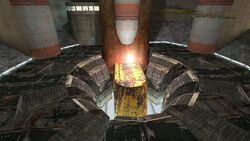
An early version of the Citadel Core.
- The Air Exchange train wreck[1] was reused at the start of the chapter Lowlife.
- The huge destroyed concrete level at the start of Vertigo seem to have been re-used in the City 17 Underground in the chapter Lowlife, where Gordon and Alyx are fighting Antlions and Gordon must find cars to block the Antlion holes.
- The Stalkers, originally to be fought in Half-Life 2, are at last directly confronted in Episode One.
- The Citadel Core was to appear in Half-Life 2, since a prototype map exists in the WC mappack.
- The Advisor room. The tube used by Advisor Pods to leave exists in a very old WC mappack map.
Episode Two
- The Air Exchange train wreck[1] was reused at the very start of the game, while at some point wrecked train cars in a valley were to be seen at the end of the Canals before Ravenholm, somehow recycled for the start of Episode Two.[2]
- The Antlion caves.
- The Antlion Grubs, that were to be met in those caves.
- The Antlion King, that was also to be met in those caves, recycled into the Antlion Guardian.
- Some mining themes cut from Ravenholm, such as carts, were reused for the Victory Mine area.
- The Combine Guard AI was recycled for the Hunter.
Episode Three
- The Borealis will most likely be seen or visited, as the Aperture Science ship.
- Kraken Base, the Arctic base where Judith Mossman probably sent her message from, might also be visited, possibly under a different name. Helena Mossman was indeed stationed in Kraken Base in the early storyline.
- A battle similar to the Weather Control might take place as a final showdown to the series.
- The chopper flight originally for Vertigo might be reused at the start of the game, ending with a similar crash.
Mods
Since the release of the retail game in 2004, many attempts have been made to restore the original storyline by making mods based on the leaked files. Some mods never went further than rough development stages and some fixes, some are still in development. Also, some players fixed several maps without including them in a full game. These can be found across the web.
One of the most famous mods based on the Beta, and actually the only to have ever been released, though in an incomplete stage, is Missing Information. Though originally considered "illegal content' by Valve. The mod has since been considered legal as long as it is distributed for free as a mod, and does not use the original source code. The mod's current version includes the E3 2003 and the Borealis chapter, though quite incomplete, and another release is expected soon. Other unreleased mods include Half-Life 2 (GabeN), Half-Life 2: BetaSource, Dark Atmosphere, CASTE, and Project-9 (see Mods based on the Beta).
E3 2003
Several demos of work-in-progress levels were shown at E3 2003.
List of demonstrations
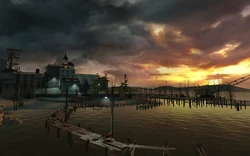
The Traptown docks seen in the E3 2003 presentation.
- A trailer (featuring very early footage)
- "G-Man" (facial animations)
- "Docks" (featuring early docks near Ravenholm)
- "Kleiner's Lab" (featuring an early Kleiner's Lab sequence)
- "Tunnels" (featuring sewer areas partially recycled for the late chapters of Half-Life 2)
- "Bugbait" (featuring a daytime Nova Prospekt)
- "Barricade" (featuring a street battle against Metrocops, with Barney and Rebels)
- "Coastline" (featuring an early Dock 137 sequence)
- "Psyche" (a dreamy sequence featuring the G-Man and other pictures)
- "Striders" (featuring a Rebel battle against Striders)
The original demos, .cfg files used to record the demos and .bat files (demoloop.bat) used to start the demos played at E3, are included in the 2003 leak, but there are so many differences between the engine used at E3 and the leak's that it is impossible to play them.
Of note is that all the 2003 leaked Beta demonstrations are broken in one way or another. Most stem from missing models and incorrect usage of props (ex. the game uses a prop_physics for a model, when the engine only thinks that prop can be prop_static, so it deletes it). Almost all the presentations have been fixed and included in the mod Missing Information.
- The G-Man emotions demo will not work, as the Half-Life G-Man model produces an error, thus preventing the movie from even starting.
- The Source engine demos are greatly affected by certain models being the wrong version; most of the revolving slabs at the start will turn into error signs. The camera is broken, as it faces only one direction. The G-Man immediately dies when spawned, and the camera will not change direction when the Headcrab knocks it over. The ground eruption at the start of the physics demo never works, but that demo is otherwise the same.
- Kleiner's Lab is also extremely broken; Alyx and Kleiner do not walk around and their lips do not move. In addition, most of the dialog is not in the game, generating a great amount of errors. However, the player can still watch the Strider blow up the wall and get the SMG from Alyx, even though she lacks the "give the player the SMG" animation.
- Traptown is extremely broken as well. The metal bars that are supposed to hit the soldiers around halfway through the demo are released as soon as the map begins because the game deletes the objects restraining it. The "Troop forcing open the door" scripted sequence only works about half of the time, the soldier on the third floor of the building never appears, the player can hear distorted music in the building, the radiator constraint is broken, tossing a grenade under the trash can will crash the game, and the blade trap at the end does not work.
- Coastline is the only demo that is still in good shape, but it lacks a sound effect (a soldier saying "Stop!" as the player get near the back of the harbor). Otherwise, it works.
- The Psyche demo works except for the non-precached G-Man voice and obsolete "env_fov" entity that replaced with "env_zoom" in retail and playable Beta.
E3 demonstrations cut from the final game
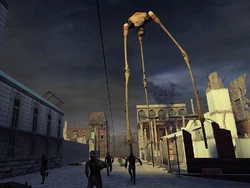
Citizens fleeing from a Strider in the map e3_strider.
Many E3 2003 demonstrations never made the cut, either. The most popular among users, found in the 2003 leak as unfinished maps, are:
- Terminal, whose remnants can still be found today on the Half-Life 2 box art. It was also used in the Half-Life 2 teaser trailer. The column mounted by a horse statue however made the final cut in the map preceding Gordon's first travel into the Citadel.
- Industrial, which featured an extremely early concept, the Combine Factories, featuring children.
- Depot, a map showing parts of the Wasteland area surrounding the Depot and a lighthouse. The Depot was kept for the Nova Prospekt level, while the lighthouse is featured in the rebel base Lighthouse Point.
Some other maps, which are very incomplete, are:
- Strider, which was actually almost complete, with the exception of missing scripts which made it unplayable. Some parts of it were later recycled to use in the Hydra demo. One of the earliest official Half-Life 2 screenshots shows the working map. It is one of the only pictures which shows a group of citizens with gas masks, when the Air Exchange was still in the storyline, intoxicating the air. It was also used in the teaser trailer. Its design was based of the very first Half-Life 2 demo, Get Your Free TVs!.
- Sniper, which started as a player running through a ruin-covered street to kill a sniper. This is also the earliest leaked map using the sniper.
The E3 preview of Gordon visiting Kleiner's Lab after first meeting Alyx contains different dialog between Alyx and Kleiner than in the version viewable online: it shows a slightly different design for Alyx and ends with the lab being attacked by Striders, an event that does not occur in the final game.
Menu gallery
References
- ↑ 1.0 1.1 1.2 1.3 1.4 1.5 Half-Life 2: Raising the Bar
- ↑ 2.0 2.1 2.2 2.3 WC mappack Cite error: Invalid
<ref>tag; name "WC mappack" defined multiple times with different content Cite error: Invalid<ref>tag; name "WC mappack" defined multiple times with different content Cite error: Invalid<ref>tag; name "WC mappack" defined multiple times with different content - ↑ Playable Half-Life 2 Beta files
- ↑
 Half-Life 2 at E3 2003: Coastline on YouTube
Half-Life 2 at E3 2003: Coastline on YouTube
See also
Inside Kraken Base.
See these related articles for more information on the early Half-Life 2.
External links
Misc.
- "I need the assistance of the community" - the original thread created by Gabe Newell on the Halflife2.net forums on October 3, 2003
- The Boy Who Stole Half-Life 2 - article about Axel Gembe on Eurogamer
- The Truth Behind The Half-Life 2 Robbery on Rock, Paper, Shotgun
Beta footage
 Half-Life 2 E3 2003 Trailer on YouTube
Half-Life 2 E3 2003 Trailer on YouTube First sight of the Source engine at E3 2003, part 1 on YouTube
First sight of the Source engine at E3 2003, part 1 on YouTube First sight of the Source engine at E3 2003, part 2 on YouTube
First sight of the Source engine at E3 2003, part 2 on YouTube Gameplay in various maps on YouTube
Gameplay in various maps on YouTube- Video of the original Kleiner's Lab sequence (test) for the Beta-based mod Dark Atmosphere on RuTube
Mods based on the Beta
- Team GabeN (part of Gabe's Love Tub, released but some works in progress left)
- The Axel Project (a rebuild of the Source Engine leaked in 2003)
- Beta Project (Russian website providing several mini mods and single maps released from time to time)
- CλSTE (unreleased)
- Missing Information (released, some work in progress left)
- The Origin (unreleased)
- Project-9 (unreleased)
| Companies | Gearbox Software • Junction Point Studios • Valve Corporation |
|---|---|
| Production staff | Artists • Character models • Composers • Voice actors • Writers • Other |
| Software | Achievements • Compilations • Demos • Games (Half-Life • Multiplayer • Non-canon • Portal • Third-party) • Game Engines • HL HD Pack • Mods |
| Other Media | ApertureScience.com • Books (Lab Rat • Raising the Bar) • Fan content (Films • Games • Mods • Series) • Films • Merchandise • Preliminary Findings • Soundtracks (Songs • Composers) • The Final Hours (Half-Life • Half-Life 2 • Half-Life: Alyx • Portal 2) |
| Cut content | Prospero • Half-Life Alpha • Half-Life 2 Beta • Half-Life 2: Episode Three • Half-Life 2: Episode Four |
| Misc. | Canon • Development (Commentary • Half-Life 2 • Portal • Next Half-Life game) • Mr. Valve • Retcons |
